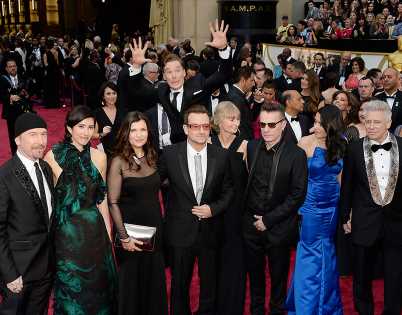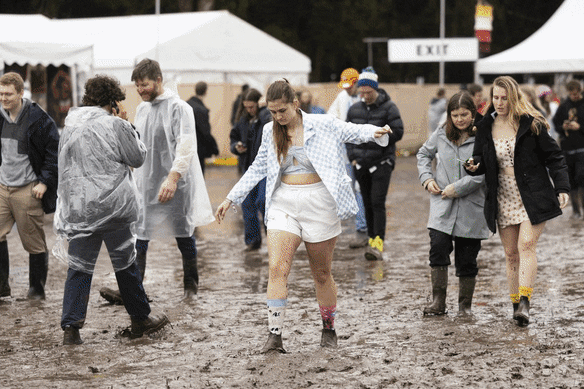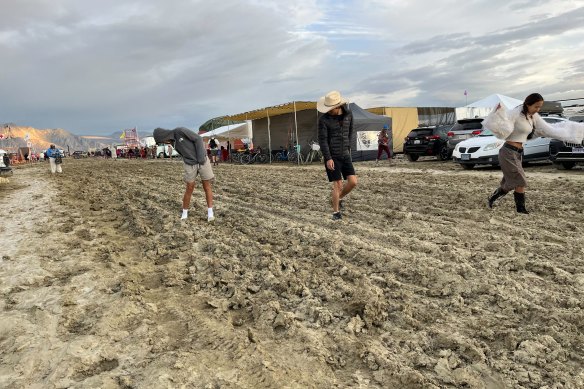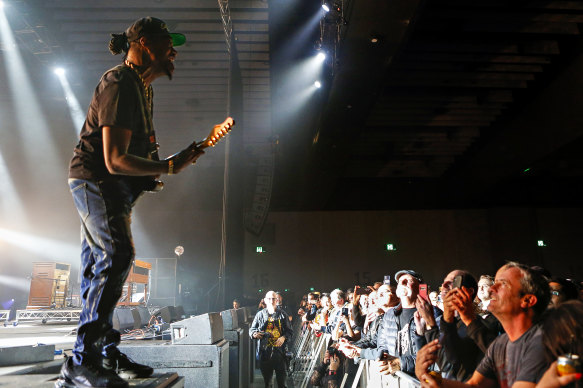
Save articles for later
Add articles to your saved list and come back to them any time.
Outdoor music festivals have traditionally conjured images of sprawling fields peppered with tents, glitter-coated patrons and lines of dubious-smelling portable toilets. But today’s music festivals are as likely to be known for something more sinister: extreme weather of the kind that led to 70,000 Burning Man attendees trapped on site for days just this week.
Since 2013, about 41 Australian music festivals have been disrupted by bushfires, floods, lightning storms, wind or extreme heat. The vast majority of these disruptions occurred in the last three years, with over 20 festivals being relocated, postponed or cancelled due to dangerous weather fuelled by climate change. The biggest of these was Splendour in the Grass in 2022, which had its first day cancelled following heavy rain and floods.
Music festivals are bearing the brunt of climate change, as floods and fires tear through venue spaces at alarming rates.
Music industry figures have been forced to confront a vital question. If the level of disruption continues at this rate, how much longer can outdoor music festivals continue, and what do they need to change to survive?
Though weather has always been a consideration when planning large outdoor events, Tara Medina, co-founder of Strawberry Fields – a music festival in Tocumwal, NSW that was cancelled because of La Niña-related flooding last year – says climate change has made extreme weather more frequent, severe and unpredictable.
“The weather for our first four or five events was reasonably consistent,” Medina says. “The variance was: you’re either going to get 20mm of rain, and it’ll be colder, or it’s going to be 35 degrees and hot. The extremes for us now are: it’s going to be 42 degrees and a catastrophic bushfire day, or it’s going to be seven metres underwater. The sweet spots are getting more and more rare.”
Other popular festivals such as Yours and Owls in Wollongong, The Grass is Greener in Canberra and Geelong and Splendour In The Grass in the Northern Rivers were either partially or entirely cancelled shortly before the events were due to begin last year – a period that was supposed to mark the festival circuit’s glorious comeback after its COVID-induced hiatus. Splendour In The Grass became “Splendour In The Mud” after its first day of acts were axed following non-stop rain along the NSW coast. Now, the festival – usually the biggest in the country – is struggling to sell out, and major international acts are cancelling their sets.
This could be catastrophic for local artists who depend on festivals for exposure, as well as the Australian music scene at large, says Catherine Strong, an associate professor at RMIT who has researched the impact of climate change on music festivals.
“We’re used to having this period where overseas bands come to play the festivals and then play other venues as well,” Strong says. “It means Australians have an opportunity to see acts they otherwise may not have been able to. These disruptions could threaten Australia’s viability as a touring stock on a worldwide level.”
It’s not just Australian festivals that are facing these threats. Croatia’s Fresh Island Festival was temporarily evacuated because of a forest fire in 2019, and, more recently, about 70,000 people became trapped at Nevada’s Black Rock Desert after this year’s Burning Man festival became a quagmire after a deluge of rain.
Extreme weather trapped Burning Man patrons at the site for days.Credit: Mike Smith
These kinds of worst-case scenarios not only deter festival-goers from buying tickets in advance (or from going entirely), they also contribute to already skyrocketing insurance premiums. Managing director of the Australian Festival Association Mitch Wilson says some operators, particularly smaller outfits, have seen premiums increase between 300 and 500 per cent since the pandemic began.
Medina adds that festivals are now having to purchase insurance policies far earlier than usual (she arranged Strawberry Field’s insurance about eight months earlier this year) in case extreme weather impacts the venue before the cancellation insurance is finalised.
“Last year, we were offered our insurance about two weeks after the floodwaters came in,” Medina says. “Our excess for this year will be over $150,000. It’s a much more challenging scenario than six or seven years ago, when policies were cheaper, excesses were lower and securing a policy was a non-question. Some insurers just don’t want to touch events now.”
Cultural sociologist at Griffiths University Ben Green says music festivals have become a canary in the coal mine for other parts of arts sector. Though each event will bear the brunt of climate change differently – depending on its location, time of year and how prepared they are for extreme weather – Green says continuing business-as-usual could endanger the longevity of these major events.
“Over a long enough time frame, music festivals as we know them will become unviable,” he says.
Ben Tillman, co-founder of Yours and Owls, says they’re already taking measures to reduce the risk of extreme weather, relocating their event to the grounds and surrounds of The University of Wollongong this year so that they have access to better infrastructure like drainage while still being outdoors.
YOURS AND OWLS PICS HERE
“We’re mitigating the risks of the things we can control, but we can’t control the weather,” Tillman says.
And with extreme weather becoming more frequent and severe, these kinds of solutions may quickly become less effective. So, if music festivals cannot continue as is, what could the more climate-friendly festivals of the future look like?
Green says organisers may turn to smaller-scale localised events that require less travel and create less waste, such as festivals sprawled throughout city streets and more indoor sets.
For example, Byron Bay’s iconic Bluesfest launched in Melbourne and was held indoors. Similarly, Sydney’s Laneway Festival moved from Callan Park to the covered Sydney Showgrounds. Wilson says he’s also noticed some festivals beginning sets later in the day and running further into the evening to avoid peak hours of sunlight and heat.
Bluesfest acts were performed indoors at the Melbourne Convention and Exhibition Centre this year.Credit: Paul Rovere
Online festivals and the use of digital technologies like holograms could also eliminate the risk of extreme weather and broaden out audiences without increasing the festival’s carbon footprint, Strong says.
“Organisers are going to have to be really innovative, but we as audiences may also just have to get used to having things happen in different ways to what we’re used to.”
However, Tillman says this misses the point of these kinds of festivals. “A big part of festivals is that they’re outdoors – that cultural experience of downtime between listening to bands, the walk between stages, being in nature.”
Medina agrees, adding that converting festivals to indoor events is a “Band-Aid solution” that ignores the bigger issue: climate change.
Green says there hasn’t been enough open discussion about climate change mitigation within the music industry, particularly between industry and government, adding that the federal government’s five-year plan to revive the arts, the National Cultural Policy, largely neglects climate change adaptation.
“Left to their own devices, the music industries aren’t adapting to climate change and mitigating the effects,” Green says. “We need the government to step in and help these industries plan – to address matters that are well beyond economic concern, but also of social and cultural importance.”
Wilson says he’s currently asking the federal government to partner with the Australian Festival Association on a national research project that would examine both how climate change impacts festivals and the sustainability of such events.
But beyond government and industry, Medina says festivals above all need audiences to commit to buying tickets early. “If we don’t know whether the crowds are going to show up, then what are we fighting for? Without their trust, we don’t have the confidence to invest in the future.”
Find out the next TV, streaming series and movies to add to your must-sees. Get The Watchlist delivered every Thursday.
Most Viewed in Culture
From our partners
Source: Read Full Article


